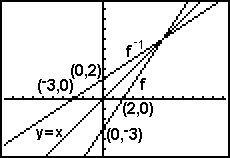108301 108601 |
Page 1: Starting with line 19, we note that there is an inconsistent use of characters for the "negative" sign. A reader needs to be careful to recognize
| At line 24 add |
|
Page 2:
| At line 11 add |
|
| At line 17 add |
|
| At line 32 add |
|
| At line 10 add |
|
|
| At line 18 add |
|
| At line 31 add |
|
Page 7:
| At line 19 add |
|
At line 28 change the sentence that starts "Sets that have a final..." to "Sets of natural numbers that have a final...".
Page 8:
Line 12: just a small note that
 is not a real number.
is not a real number.
Page 10:
| At line 11 add |
|
| At line 24 add |
|
Page 11:
| At line 30 add |
|
Page 15:
| At line 10 add |
|
| At line 25 add |
|
Page 16:
| At line 17 add |
|
At line 35 note that there is a missing right parenthesis after Example 10 and before TI-89.
Page 21:
At line 31 there is an extra space before the comma.
Page 23:
| At line 18 add |
|
Page 24:
At line 36, add the following two sentences to the footnote: "Also, we saw before that the complex number 5+7i is written as (5,7) on the TI-86. This ia yet a third use of the same notation."
Page 26:
At line 25, Example 8 should end with "of the interval."
Page 29:
| At line 9 add |
|
| At line 16 add |
|
Lines 17-25: The image shown is from a TI-92, not a TI-89. We need to either change the heading, or change the image. The correct TI-89 image is given in the following explanation page.
| At line 18 add |
|
| At line 31 add |
|
Page 30:
| At line 23 add |
|
Page 31:
At line 33: Note that the image in the book is from a TI-92, not a TI-89. The difference is in the amount of space allowed for the display.
Page 32:
| At line 12 add |
|
Page 42:
| At line 13 add |
|
At line 28: change the text to ...axis (which is positive to the right of the y-axis) represents the first coordinate of the an ordered pair, while the y-axis (which is positive above the x-axis) represents the second coordinate of an ordered pair.
The location of an ordered pair of real numbers
Page 43:
At line 10: Note that the point A, being on the y-axis, can not be seen as a distinctly graphed point on this calculator image.
Page 48:
At line 19: In example 7, consider changing the word "relations" to "functions".
Page 50:
| At line 11 add |
|
Page 60:
At line 8: In example 7, item c, there is nothing wrong with having a problem that is (g/f)(1), but the change from (f/g) to (g/f) just seems to sneak in here.
Page 61:
At line 7: Note that we should add the "x is not equal to 3".
Page 82:
At line 3: Change to "A function that "reverses" the operation of another function is called the inverse function of that other function.
At line 24, the purpose of the box with the "reverse first" and arrow becomes a bit more clear after one has read a few more lines. However, that box is confusing in the context of reading it for the first time.
Page 84:
At line 5: We need to replace the graph. For one thing, the line "y=x" is not drawn through the point of intersection. Also, the graph does not have equal spacing on the x and y coordinates. As a consequence the line "y=x" does not look right. And, because the lines are "drawn" in the graph, it does not appear as a calculator image. Consider using the following graph

©Roger M. Palay
Saline, MI 48176
September, 2000